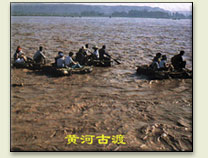Yellow pigments (goethite and clay) were used the in the wall paintings in the cave of Lascaux 17 000 years ago. Yellow ochre was used by ancient Egyptians to depict skin tones or for painting backgrounds in their wall paintings. Egyptian hieroglyphs are the only known script using color to express meaning - the word "woman" for example was written in yellow characters.
The poisonous yellow pigment orpiment (arsenic sulfide) was prepared by grinding the naturally occuring mineral and used in ancient Egypt but also later in Assyria and China for painting walls and in paintings and illuminated manuscripts. Other more modern yellow pigments frequently used in paintings, such as Naples yellow (lead antimonate) and Chrome yellow (lead chromate) are poisonous too.
Ancient Chinese and all Asian cultures considered yellow to be the color of joy, glory and wisdom. Starting with the 3rd millennium B.C. yellow was associated by the chinese with power and domination, the same role played by red and purple in Roman Empire and in Medieval Europe. Saffron-yellow dyed robes were worn exclusively by the Emperor and Buddhist monks.
The origin of this meaning of yellow for the Chinese is supposedly the Yellow River (Huang-Ho). The river is named according to its color caused by big amounts of yellow mud carried by its waters.This extraordinarily fertile mud is deposited on the banks of the river in layers up to a thickness of 600 feet.
Many cultures ascribed protective powers to the colors yellow and red. Indian brides wore ragged yellow clothes before the wedding to chase away evil spirits. Yellow is the wedding color for people in Egypt, Russia, the Orient and in some of the Balkan countries. In other areas and cultures yellow was the color of bad fortune. Itinerant traders avoided this color and the curtain in theaters must not be yellow for fear of bad fortune.
(main yellows page) - Naples yellow - Orpiment - lead tin yellow - Orpiment - cadmium yellow - chrome yellow - - Yellow ochre - Cobalt yellow - Indian yellow - Lemon yellow

